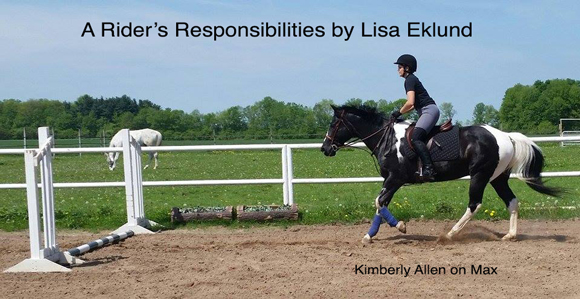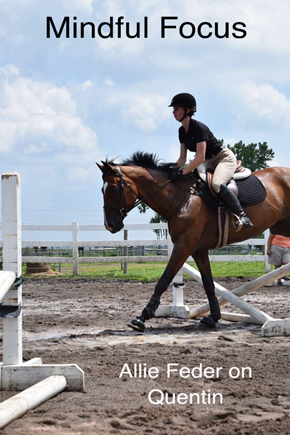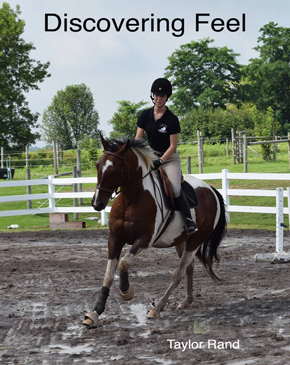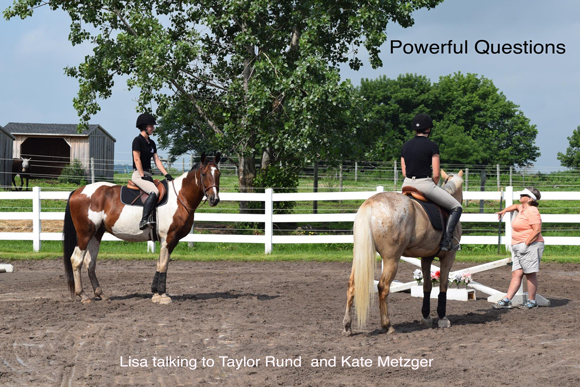A Rider’s Responsibilities
by Lisa Eklund

Does this sound at all familiar? It’s a weekday afternoon and it is time for your weekly lesson. After grooming and tacking up, you go into the ring and warm your horse up while waiting for your trainer. Your trainer enters the ring and begins your lesson. This lesson seems very familiar as you have heard your trainer ask you to fix the same things for a long time. You work very hard in your lesson to fix any issues and return for another lesson the next week. You wonder why, once again, little has changed. You don’t understand why sometimes your trainer seems frustrated. Isn’t it their job to fix these problems you have? Do you need a new saddle, a new horse, a better trainer? Most likely you don’t. What you may need is a shift in perspective by making a commitment to taking responsibility for your riding success. This does not happen by focusing only on that weekly lesson. It happens through continual hard work, both on and off your horse.
Rider Application
So how do you, as a rider, take responsibility for your riding and improve your skills? How  do you shift your perspective? Before any real work can get done, take time to sit down and look inward and be very honest with yourself. This inward reflection can be very hard as we often want to look outward for reasons to the causes of our problems. Self-reflection is necessary in order to find that part of you that is strong and capable of forging forward, remaining positive and learning from your failures. This is a time where you need to be present with your weaknesses as well as your strengths. It is a time of focused awareness where you will be able to recognize what is keeping you stuck in your riding. Are you afraid to try because you may make a mistake and have to admit failure? Is your general work ethic lacking? Do you have physical fears that prevent you from doing more? Are you someone who always carries a negative attitude into your lesson? Are you unable to leave your daily worries at the door when you walk in the barn? Do you tend to have a victim mindset, where you think that if only you had better circumstances you would be a better rider? These are just a few of the ways we can get stuck in our progress as a rider and in our progress in life.
do you shift your perspective? Before any real work can get done, take time to sit down and look inward and be very honest with yourself. This inward reflection can be very hard as we often want to look outward for reasons to the causes of our problems. Self-reflection is necessary in order to find that part of you that is strong and capable of forging forward, remaining positive and learning from your failures. This is a time where you need to be present with your weaknesses as well as your strengths. It is a time of focused awareness where you will be able to recognize what is keeping you stuck in your riding. Are you afraid to try because you may make a mistake and have to admit failure? Is your general work ethic lacking? Do you have physical fears that prevent you from doing more? Are you someone who always carries a negative attitude into your lesson? Are you unable to leave your daily worries at the door when you walk in the barn? Do you tend to have a victim mindset, where you think that if only you had better circumstances you would be a better rider? These are just a few of the ways we can get stuck in our progress as a rider and in our progress in life.
Finding a quiet place to meditate can help you really be honest with yourself about your strengths and weaknesses. Quiet reflection is a way to gain clarity of insight and to see how we get ourselves stuck in a pattern of behavior. If meditation is not for you, finding anyplace quiet and just being with your breath can do. A walk in nature may also help you to be quiet enough to look inward. Some people put their thoughts down in writing in order to help find that honesty. It doesn’t matter how you find your way to quiet, honest reflection. It just matters that you do. Many of the mental strengths and weaknesses that you recognize will be seen in every part of your life.
.
Once you recognize both your strengths and weaknesses, you need to build on those strengths and regularly work on improving those areas where you are weak. You may identify physical weaknesses or mental ones or both, but in actuality, there is always a mental component to our continuing physical weaknesses. If you don’t choose to make a real commitment to fixing physical issues, for whatever reason, you have made a mental choice to stay stuck. This commitment is not just for when you walk in the ring for a lesson. It is for every time you sit on a horse, even when standing and resting or cooling out, you work on fixing those weaknesses. Additionally, committed riders will work off the horse to learn. As I am writing this article, I am listening to the George Morris’ commentary on the Maclay Finals. Even though I know I need to get this article done, I don’t want to lose this wonderful opportunity to listen and learn. Riders today are so lucky to have all of the resources to see the best riding and hear the best advice, while sitting at home at their computer. There are also many clinics now that you can attend, but the commitment to learning in every way you can is up to you. It is your choice. No one else, including your trainer, can make that happen. If you are in a group lesson it is your responsibility to watch everyone else and learn from them. Listen to what your trainer has to say about their rides so you can apply it to yourself. It is disappointing when a rider in a group does not watch everything that is going on, as it shows that the real commitment is not there. No one else can create that commitment. You have to do that all on your own. As a rider you need to make a commitment to physical strength and health as well. That includes working out, healthy eating, and getting enough rest.
.
That commitment includes not coming up with excuses; recognizing your weaknesses and mistakes is the very first step in fixing them. Finding excuses is just a way to massage the ego and a block to moving forward. You are the person in control of everything you do on a horse. No one else can do it for you and no one else is to blame if the same mistakes happen all of the time and you do not progress in your riding. Of course, you can always find that higher quality horse, more expensive saddle, or even a different trainer. While that may be necessary at times, it won’t do you a lick of good if you don’t take responsibility for fixing your own metal and physical weaknesses.
.
Another important aspect to being a true horseman and great rider is learning all aspects of horse care and training. Time spent off the horse grooming, cleaning stalls, turning out, feeding, wrapping, learning from the farrier, veterinarians and other experts, and doing everything it takes to maintain a healthy horse will make you a real horseman. Don’t depend on others to do it for you. Know your horses inside and out and ride as many different horses as you can. Understand how all the equipment and tack you use works and how all the tack in the barn works and fits on different horses. Watch and learn from other disciplines as well. Many of the best horsemen of the past rode and competed in many disciplines, which is what helped make them great.
.
As a rider you also have to be responsible for developing your feel. Some people will have  a natural feel and some won’t, but it can be developed and only the rider can do it. Your trainer can explain what feel is but it is up to you to recognize when things feel right and when they don’t. You need to be aware of what you did when things felt right and try and reproduce that feeling, and recognize when things weren’t right and what that felt like in order to know when you need to change something. Also, don’t be afraid to try something new on your own. Use your critical thinking skills and analyze a situation in order to come up with some ideas for change. Try out your ideas and when they work keep them in your riding toolbox. Don’t be afraid to make mistakes that is how you learn.
a natural feel and some won’t, but it can be developed and only the rider can do it. Your trainer can explain what feel is but it is up to you to recognize when things feel right and when they don’t. You need to be aware of what you did when things felt right and try and reproduce that feeling, and recognize when things weren’t right and what that felt like in order to know when you need to change something. Also, don’t be afraid to try something new on your own. Use your critical thinking skills and analyze a situation in order to come up with some ideas for change. Try out your ideas and when they work keep them in your riding toolbox. Don’t be afraid to make mistakes that is how you learn.
Finally, one of the most important things you as a rider can do, is learn to be more mindful. To be mindful, you need to live in the present moment, letting go of what was or what might have been. Mindfulness will enable you to recognize patterns in your thoughts and behavior that get in the way of your progress. Once recognized, you then have the choice to shift your behavior and choose a different path. . Many of your mental strengths and weaknesses will show up in all aspects of your life. The beauty of learning a skill is that, if you choose to do so, you can learn more about yourself and begin to live a more purposeful and mindful life. Life work you do outside of your riding will help you on your horse and the mental work you practice on your horse will help you in life. As you begin to live your life more authentically, the new skills you are learning will become effortless. Scientists studying neuroplasticity have discovered that the mind can change the brain and new neuropathways can be developed to change old habits and behavior. However, this does require hard work and determination and a “growth mindset.” Consider how liberating this is— we are not doomed to be stuck in our same behavioral patterns. We can learn from our failures, by making them into lessons to improve on in the future. We do have the choice to shift our perspectives and change our behaviors. There really are no excuses not to do so.
Trainer Application
Trainers need to teach all the hard skills it takes to ride. That is a given, but another important job is helping a rider learn more about themselves, their beliefs, their reactions, and their fears. A trainer can also help the rider stay accountable for their progress and keep helping the rider create perspective shifts. It is important to really listen to what a rider has to say, to recognize body language in clients, and to “hear” what is going on under what is said aloud. This powerful listening can lead to questions that will help bring a rider into self-awareness. Powerful questions generally start with what and how, not why. Why questions are usually judgment based. What and how questions are generally not. In any case, questions need to be non-judgmental and open ended. Yes or no answers will not provoke self-reflection.
This powerful listening can lead to questions that will help bring a rider into self-awareness. Powerful questions generally start with what and how, not why. Why questions are usually judgment based. What and how questions are generally not. In any case, questions need to be non-judgmental and open ended. Yes or no answers will not provoke self-reflection.
.
Recently I had a rider stuck in her riding and she said she was very frustrated. I mentioned to her that being frustrated will not help her in this situation. I then asked, “What will help you?” She immediately answered, “I don’t know.” I replied, “Yes, you do.” I asked the question once again. I held her accountable for finding the answer to her question. She wanted me to tell her, and while. I could have, coming up with the answer herself made her accountable for stopping her frustration and choosing a new solution. It also helped her to remember the lesson. Her answer finally was, “I can figure out what went wrong and come up with a solution. ”She did, and she began to get unstuck and improved immediately. She let her frustration go.
.
As a trainer you can help your clients become more self-aware. You can share life lessons you have learned and share with them the tools you used to shift your perspectives and behaviors. Helping a student learn how to breathe and be in the moment is a powerful tool. Introducing your riders to meditation techniques is also a great way to help towards helping a rider find deeper awareness. As a trainer, you first need to practice the same things that you are teaching your clients. You need to study everything you can about the physical and mental aspects of riding and training, and you need to understand human behavior as well as equine. Be a student of life. You can sit quietly and meditate and see where you are stuck in your behaviors both as a trainer and in other areas of your life. You can commit to shifting your perspectives to leading a more positive life.
.
You also can model all the behaviors you would like your clients to have. This is not easy. Don’t punish yourself if you don’t always get it right. Recognize your mistakes, learn from them and move on. You also need to be that consummate horseman that I recommended a rider needs to be. Know your horse, barn, equipment, and everything connected to running your business inside and out. Know your riders well, but most importantly be mindful and know yourself. Your riders will recognize this authenticity, forgive you for your mistakes, and trust you to do your best for them.


